|
|
|
Sort Order |
|
|
|
Items / Page
|
|
|
|
|
|
|
| Srl | Item |
| 1 |
ID:
123169
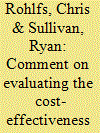

|
|
|
|
|
| Publication |
2013.
|
| Summary/Abstract |
This comment discusses the pros and cons of the methodology and data used in our previous study on the cost-effectiveness of armor on Tactical Wheeled Vehicles (TWVs), and responds to recent critiques by Franz Gayl. In our previous article, we evaluated the large-scale Army policies to replace relatively light Type 1 Tactical Wheeled Vehicles (TWVs) with moderately protected Type 2 variants, and later to replace Type 2s with heavily protected Type 3s. We find that the switch from Type 2 to Type 3 TWVs did not appreciably reduce fatalities and were not cost-effective. Mr. Gayl contends that the data and choice of control variables used in our original study negatively bias our findings for Type 3 TWVs. We defend our previous conclusions and argue that Gayl's suggested approach of focusing on deaths per insurgent attack fails to account for effects of the vehicles on when, where, and how attacks occurred. Our methodology does not suffer from this bias and measures effects on total unit casualties rather those incurred per attack. We explain that our estimates are stable across many specifications and are not sensitive to the choice of controls as Gayl suggests.
|
|
|
|
|
|
|
|
|
|
|
|
|
|
|
|
| 2 |
ID:
121745
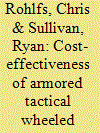

|
|
|
|
|
| Publication |
2013.
|
| Summary/Abstract |
This study uses for official use only data on US military operations to evaluate the large-scale Army policies to replace relatively light Type 1 tactical wheeled vehicles (TWVs) with more heavily protected Type 2 variants and later to replace Type 2s with more heavily protected Type 3s. We find that Type 2 TWVs reduced fatalities at $1.1 million-$24.6 million per life saved for infantry units, with our preferred cost estimates falling below the $7.5?million cost-effectiveness threshold, and did not reduce fatalities for administrative and support units. We find that replacing Type 2 with Type 3 TWVs did not appreciably reduce fatalities and was not cost-effective.
|
|
|
|
|
|
|
|
|
|
|
|
|
|
|
|
| 3 |
ID:
110718
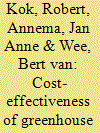

|
|
|
|
|
| Publication |
2011.
|
| Summary/Abstract |
A review is given of methodological practices for ex ante cost-effectiveness analysis (CEA) of transport greenhouse gas (GHG) mitigation measures, e.g. fuel economy and CO2 standards for road vehicles in the US and EU. Besides the fundamental differences between different types of policies and abatement options which inherently result in different CEA outcomes, differences in methodological choices and assumptions are another important source of variation in CEA outcomes. Fourteen methodological issues clustered into six groups are identified on which thirty-three selected studies are systematically reviewed. The potential variation between lower and upper cost-effectiveness estimates for GHG mitigation measures in transport, resulting from different methodological choices and assumptions, lies in the order of $400 per tonne CO2-eq. The practise of using CEA for policy-making could improve considerably by clearly indicating the specific purpose of the CEA and its strengths and limitations for policy decisions. Another improvement is related to the dominant approach in transport GHG mitigation studies: the bottom-up financial technical approach which assesses isolated effects, implying considerable limitations for policy-making. A shift to welfare-economic approaches using a hybrid model has the potential to establish an improved assessment of transport GHG mitigation measures based on realistic market responses and behavioural change.
|
|
|
|
|
|
|
|
|
|
|
|
|
|
|
|
| 4 |
ID:
113415


|
|
|
|
|
| Publication |
2012.
|
| Summary/Abstract |
This paper presents an analysis of the cost-effectiveness of high-efficiency appliances in the U.S. residential sector using cost and efficiency data developed as part of the regulatory process of the U.S. Department of Energy's Appliances and Commercial Equipment Standards Program. These data are presented as a case study in the development of an 'efficiency technology database' which can be expanded and published as a resource to other researchers and policy makers seeking scenarios that optimize efficiency policies and forecast their likely impacts on energy demand and greenhouse gas emissions. The use of this data to evaluate cost-effectiveness according to a variety of metrics is demonstrated using the example of one refrigerator-freezer product class. Cost-effectiveness is then evaluated in terms of cost of conserved energy for refrigerators, room air conditioners, water heaters, cooking equipment, central air conditioners and gas furnaces. The resulting potential of cost-effective improvement ranges from 1% to 53% of energy savings, with a typical potential of 15-20%.
|
|
|
|
|
|
|
|
|
|
|
|
|
|
|
|
| 5 |
ID:
111357


|
|
|
|
|
| Publication |
2012.
|
| Summary/Abstract |
The twelfth five-year plan (FYP) endorsed by the People's National Congress in March 2011 plays a crucial role in shaping China's development trajectory over the next decades , and especially for the fulfillment of the 40-45 carbon intensity reduction target by 2020. The plan will condition both the medium and long term perspectives of economic restructuring, rebalance between the inclusive economic growth and environmental objectives, which are compounded by multiple constraints faced by China such as aging population, natural resources depletion, energy supply security and environmental deterioration. This article investigates the major energy and climate targets and actions specified in the 12th FYP to gain insights into the nature and magnitude of challenges and difficulties with regard to the medium and long run economic and environmental policies. It points out that China should articulate sectoral policies with the global climate mitigation targets to avoid long term carbon lock-in. Based on an in-depth analysis of the objectives in the plan, it is argued that the implementation should include mainstreaming developments of appropriate instruments to support cost-effective energy efficiency improvements and carbon intensity reduction in the next five years.
|
|
|
|
|
|
|
|
|
|
|
|
|
|
|
|
| 6 |
ID:
123168
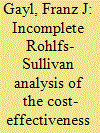

|
|
|
|
|
| Publication |
2013.
|
| Summary/Abstract |
This comment addresses the Rohlfs-Sullivan analysis titled: 'The Cost-Effectiveness of Armored Tactical Wheeled Vehicles [TWVs] for Overseas US Army Operations.' The analysis evaluated policies to replace Type 1 and 2 TWVs with Type 3s. There is no evidence the analysis factored in fatality causes, fatality relationships to vehicles, or compared survivability of vehicles. Furthermore, it did not note when Type 3 TWVs were requested, when they impacted fatalities, or TWV use policies. It also assumed Type 3 TWVs prompted negative unit behaviors while discounting evidence of positive behaviors. In summary, the analysis is incomplete and should be revised.
|
|
|
|
|
|
|
|
|
|
|
|
|
|
|
|
| 7 |
ID:
126843
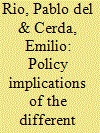

|
|
|
|
|
| Publication |
2014.
|
| Summary/Abstract |
The cost-effectiveness of support for renewable electricity is a main criterion to assess the success of policy instruments, together with effectiveness. The costs of support are also a source of significant concern for governments all over the world. However, significant confusion exists in the literature on the cost-effectiveness of public support for renewable electricity. While some authors define the concept of cost-effectiveness as that which complies with the equimarginality principle, many others, including documents from relevant organisations (European Commission, International Energy Agency, Intergovernmental Panel on Climate Change) define it as "the lowest costs of support", generally equating it with the minimisation of consumer costs. The aim of this paper is to clarify the differences between both approaches and their policy implications regarding the choice of instruments and design elements. It is shown that they partly overlap and that their policy implications clearly differ, leading to very different policy prescriptions. While the former favours technology neutral instruments and design elements, the "minimisation of consumer costs" approach favours instruments and design elements which adjust support levels to the costs of the technologies.
|
|
|
|
|
|
|
|
|
|
|
|
|
|
|
|
| 8 |
ID:
115141


|
|
|
|
|
| Publication |
2012.
|
| Summary/Abstract |
A flaw has been identified in the calculation of the cost-effectiveness in marginal abatement cost curves (MACCs). The problem affects "negative-cost" emissions reduction measures-those that produce a return on investment. The resulting ranking sometimes favours measures that produce low emissions savings and is therefore unreliable. The issue is important because incorrect ranking means a potential failure to achieve the best-value outcome. A simple mathematical analysis shows that not only is the standard cost-effectiveness calculation inadequate for ranking negative-cost measures, but there is no possible replacement that satisfies reasonable requirements. Furthermore, the concept of negative cost-effectiveness is found to be unsound and its use should be avoided. Among other things, this means that MACCs are unsuitable for ranking negative-cost measures. As a result, MACCs produced by a range of organizations including UK government departments may need to be revised. An alternative partial ranking method has been devised by making use of Pareto optimization. The outcome can be presented as a stacked bar chart that indicates both the preferred ordering and the total emissions saving available for each measure without specifying a cost-effectiveness.
|
|
|
|
|
|
|
|
|
|
|
|
|
|
|
|
| 9 |
ID:
128334


|
|
|
|
|
| Publication |
2014.
|
| Summary/Abstract |
In order to reduce greenhouse gas emissions in the United States by an order of magnitude, a portfolio of mitigation strategies is needed. Currently, many utilities pursue energy efficiency programs. We study a case where utilities could choose whether to allocate their energy efficiency budget to either end-use efficiency or vehicle electrification as a means to reduce CO2 emissions. We build a decision space that displays the conditions under which utilities should pursue either strategy. To build such decision space, assumptions are needed on how consumers respond to electric vehicle incentives, and what would be the baseline vehicle selected by consumers if no incentives were in place. Since these two aspects are highly uncertain, we treat them parametrically: if consumers are replacing a conventional vehicle with a PHEV, utility incentive programs to induce PHEV adoption appear to be cost-effective for a wide range of efficiency program costs and grid emissions factors.
|
|
|
|
|
|
|
|
|
|
|
|
|
|
|
|
|
|
|
|
|